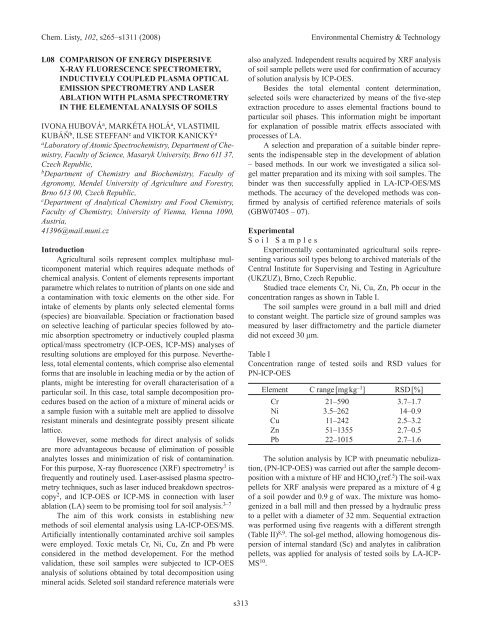2. ENVIRONMENTAL ChEMISTRy & TEChNOLOGy 2.1. Lectures
2. ENVIRONMENTAL ChEMISTRy & TEChNOLOGy 2.1. Lectures
2. ENVIRONMENTAL ChEMISTRy & TEChNOLOGy 2.1. Lectures
You also want an ePaper? Increase the reach of your titles
YUMPU automatically turns print PDFs into web optimized ePapers that Google loves.
Chem. Listy, 102, s265–s1311 (2008) Environmental Chemistry & Technology<br />
L08 COMPARISON OF ENERGy DISPERSIVE<br />
x-RAy FLuORESCENCE SPECTROMETRy,<br />
INDuCTIVELy COuPLED PLASMA OPTICAL<br />
EMISSION SPECTROMETRy AND LASER<br />
AbLATION wITh PLASMA SPECTROMETRy<br />
IN ThE ELEMENTAL ANALySIS OF SOILS<br />
IVOnA HUBOVá a , MARKéTA HOLá a , VLASTIMIL<br />
KUBáň b , ILSE STEFFAn c and VIKTOR KAnICKý a<br />
a Laboratory of Atomic Spectrochemistry, Department of Chemistry,<br />
Faculty of Science, Masaryk University, Brno 611 37,<br />
Czech Republic,<br />
b Department of Chemistry and Biochemistry, Faculty of<br />
Agronomy, Mendel University of Agriculture and Forestry,<br />
Brno 613 00, Czech Republic,<br />
c Department of Analytical Chemistry and Food Chemistry,<br />
Faculty of Chemistry, University of Vienna, Vienna 1090,<br />
Austria,<br />
41396@mail.muni.cz<br />
Introduction<br />
Agricultural soils represent complex multiphase multicomponent<br />
material which requires adequate methods of<br />
chemical analysis. Content of elements represents important<br />
parametre which relates to nutrition of plants on one side and<br />
a contamination with toxic elements on the other side. For<br />
intake of elements by plants only selected elemental forms<br />
(species) are bioavailable. Speciation or fractionation based<br />
on selective leaching of particular species followed by atomic<br />
absorption spectrometry or inductively coupled plasma<br />
optical/mass spectrometry (ICP-OES, ICP-MS) analyses of<br />
resulting solutions are employed for this purpose. nevertheless,<br />
total elemental contents, which comprise also elemental<br />
forms that are insoluble in leaching media or by the action of<br />
plants, might be interesting for overall characterisation of a<br />
particular soil. In this case, total sample decomposition procedures<br />
based on the action of a mixture of mineral acids or<br />
a sample fusion with a suitable melt are applied to dissolve<br />
resistant minerals and desintegrate possibly present silicate<br />
lattice.<br />
However, some methods for direct analysis of solids<br />
are more advantageous because of elimination of possible<br />
analytes losses and minimization of risk of contamination.<br />
For this purpose, X-ray fluorescence (XRF) spectrometry 1 is<br />
frequently and routinely used. Laser-assised plasma spectrometry<br />
techniques, such as laser induced breakdown spectroscopy<br />
2 , and ICP-OES or ICP-MS in connection with laser<br />
ablation (LA) seem to be promising tool for soil analysis. 3–7<br />
The aim of this work consists in establishing new<br />
methods of soil elemental analysis using LA-ICP-OES/MS.<br />
Artificially intentionally contaminated archive soil samples<br />
were employed. Toxic metals Cr, ni, Cu, Zn and Pb were<br />
considered in the method developement. For the method<br />
validation, these soil samples were subjected to ICP-OES<br />
analysis of solutions obtained by total decomposition using<br />
mineral acids. Seleted soil standard reference materials were<br />
s313<br />
also analyzed. Independent results acquired by XRF analysis<br />
of soil sample pellets were used for confirmation of accuracy<br />
of solution analysis by ICP-OES.<br />
Besides the total elemental content determination,<br />
selected soils were characterized by means of the five-step<br />
extraction procedure to asses elemental fractions bound to<br />
particular soil phases. This information might be important<br />
for explanation of possible matrix effects associated with<br />
processes of LA.<br />
A selection and preparation of a suitable binder represents<br />
the indispensable step in the development of ablation<br />
– based methods. In our work we investigated a silica solgel<br />
matter preparation and its mixing with soil samples. The<br />
binder was then successfully applied in LA-ICP-OES/MS<br />
methods. The accuracy of the developed methods was confirmed<br />
by analysis of certified reference materials of soils<br />
(GBW07405 – 07).<br />
Experimental<br />
S o i l S a m p l e s<br />
Experimentally contaminated agricultural soils representing<br />
various soil types belong to archived materials of the<br />
Central Institute for Supervising and Testing in Agriculture<br />
(UKZUZ), Brno, Czech Republic.<br />
Studied trace elements Cr, ni, Cu, Zn, Pb occur in the<br />
concentration ranges as shown in Table I.<br />
The soil samples were ground in a ball mill and dried<br />
to constant weight. The particle size of ground samples was<br />
measured by laser diffractometry and the particle diameter<br />
did not exceed 30 µm.<br />
Table I<br />
Concentration range of tested soils and RSD values for<br />
Pn-ICP-OES<br />
Element C range [mg kg –1 ] RSD [%]<br />
Cr 21–590 3.7–1.7<br />
ni 3.5–262 14–0.9<br />
Cu 11–242 <strong>2.</strong>5–3.2<br />
Zn 51–1355 <strong>2.</strong>7–0.5<br />
Pb 22–1015 <strong>2.</strong>7–1.6<br />
The solution analysis by ICP with pneumatic nebulization,<br />
(Pn-ICP-OES) was carried out after the sample decomposition<br />
with a mixture of HF and HClO 4 (ref. 5 ) The soil-wax<br />
pellets for XRF analysis were prepared as a mixture of 4 g<br />
of a soil powder and 0.9 g of wax. The mixture was homogenized<br />
in a ball mill and then pressed by a hydraulic press<br />
to a pellet with a diameter of 32 mm. Sequential extraction<br />
was performed using five reagents with a different strength<br />
(Table II) 8,9 . The sol-gel method, allowing homogenous dispersion<br />
of internal standard (Sc) and analytes in calibration<br />
pellets, was applied for analysis of tested soils by LA-ICP-<br />
MS 10 .

















